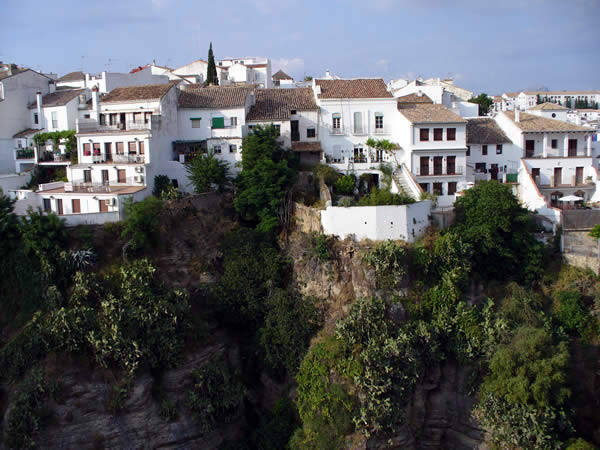This post is also available in:
![]() Deutsch
Deutsch
Ronda is a picturesque ancient town which is practically in the center of the Spanish Pueblos Blancos area. The city is in fact located in the north-west area of the province of Malaga in Andalusia. Placed on a high rock above a narrow gorge, which divides it into two distinct parts: to the south the old Arab village called “La Ciudad” and to the north the more “new” village called “El Mercadillo”. Three bridges cross the gorge, allowing the connection between the various parts of the city. The most impressive bridge is undoubtedly the Puente Nuevo built in the 18th century.
The origins of Ronda can be traced back to prehistoric times, cave paintings dating back to the Paleolithic era have been discovered in the caves of Pileta. In the area there are also the megalithic necropolises of the Dolmen of El Chopo and Encinas Borrachas.
There are numerous remains of the Roman era scattered throughout the territory of Ronda. Of particular interest are the remains of the city of Acinipo (Ronda la Veja) with its magnificent theater. With the Middle Ages and the Arab occupation, Ronda acquired great importance by becoming the capital of one of the five administrative areas of Al-Andalus, the Caliphate of Cordoba. After the dissolution of the Caliphate, the city became an independent kingdom for a short time. Later it came under the control of Granada until the conquest by the Catholic kings in 1485.
WHAT TO SEE: THE MAIN ATTRACTIONS OF RONDA
Among the most significant evidence of the Arab period, the Mandragon palace, the Arab baths (Baños Arabes), the palace of the Moor king (Casa del Rey Moro) and the walls that surround part of the city are worth mentioning.

The Catholic reconquest caused a great change in the cultural organization and appearance of the city. In the 16th century, the Iglesia de Padre Jesús, the Iglesia de Santa María, the Convento de San Francisco, the Iglesia Convento de la Merced, the Iglesia del Espíritu Santo and the Palacio del Marqués de Salvatierra were built.
But it will be the eighteenth century that will have the greatest impact on the urban aspect, giving Ronda a unique value in the context of Andalusia. In this century the most significant monuments will be built. Such as the Ponte Nuovo, the Arco de Felipe V, the Templete de la Virgen de los Dolores, the Casa Consistorial and the Plaza de Toros (1785).
The ancient part of the city still today clearly shows the strong Arab influence. Its isolated position and its fortifications make it easy to understand why Ronda was one of the last Arab outposts to fall under Christian domination. Do not miss, near the Plaza de Toros, the beautiful promenade, called Alameda del Tajo, which offers magnificent panoramic views of the Ronda mountains and the surrounding countryside.
This post is also available in:
![]() Deutsch
Deutsch

